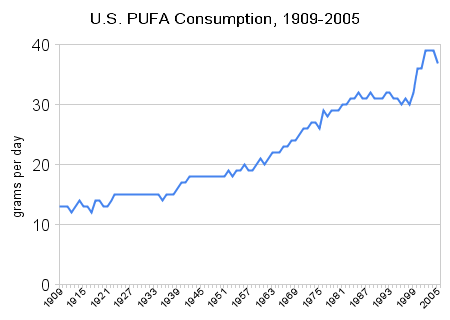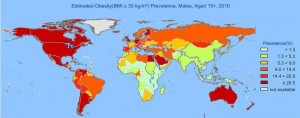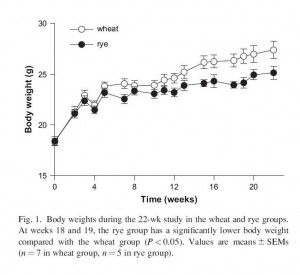After I did my post on Seth Roberts’s new therapies for circadian rhythm disorders, Seth learned of my experience with scurvy and blogged about a similar experience of his own.
Seth made the important point that food cravings are driven by nutritional deficiencies – a point I heartily agree with, which is why it’s so important for those seeking to lose weight to be well nourished – and asked, “Why do we like sweet foods?” His suggested answer was that the taste for sweetness encouraged Paleo man “to eat more fruit so that we will get enough Vitamin C.”
This led to a fascinating contribution from Tomas in the comment thread:
I have read several books on the Traditional Chinese Medicine and they attributed that increased craving for sweets is in fact signaling some serious nutritious deficiencies. They said that it’s in fact meat or starches or other nutritionally dense foods that will soothe the craving, but sweets are more readily available. The taste of meat is in fact sweet as well.
In my experience this seems (the TCM view) to be true. I always have been very skinny, but eating enormous amounts of sweets. After I switched to a proper, paleo-like diet, the situation changed in many aspects and I no longer have such strong cravings and slowly I am gaining some weight.
Shou-Ching and I have great respect for the empirical claims of Traditional Chinese Medicine, and so I found this a fascinating idea. Is our modern taste for sweets actually derived from a taste that evolved to encourage meat eating?
Human tastes
It is generally agreed that animals evolved the sense of taste to detect nutrients and toxins:
Taste helps animals to decide whether a food is beneficial for them and should be consumed or whether it is dangerous for them and should be rejected. Probably, taste evolved to insure animals choose food appropriate for body needs. [1]
The five basic human tastes are sweet, salty, sour, bitter, and umami. Each taste detects either a nutrient class we need or toxins we should avoid:
- Sweet – carbohydrate.
- Salty – electrolytes.
- Sour – acids.
- Bitter – toxins.
- Umami – glutamate and nucleotides.
Electrolytes are essential to life, and toxins best avoided, so the evolution of salty and bitter tastes is easy to understand. The umami taste is mainly a sensor for natural (healthy) protein. The sour taste is interesting, in that it is attractive in small doses but aversive in large. Seth argues that low-dose sourness is desirable because it leads us to seek out fermented foods, which supply probiotic bacteria and their fermentation products such as vitamin K2. If so, it is natural that strong sourness, indicating high bacterial populations, would be aversive.
But what of the sweet taste? Is it really a sensor for carbohydrates? If so it does a rather poor job. The healthiest carbohydrate source – starch, which is fructose-free – hardly activates this taste, while fructose, a toxin, activates it in spades. If this taste evolved to be a carbohydrate sensor, it should have made us aversive to the carbohydrates it detects, as the bitter taste makes us avoid toxins. But sweet tastes are attractive!
Sweetness activators
It turns out that the sweetness receptors are complex; many things activate them, and they appear to serve multiple functions.
Wikipedia (“Sweetness”) notes:
A great diversity of chemical compounds, such as aldehydes and ketones, are sweet.
Some of the amino acids are mildly sweet: alanine, glycine, and serine are the sweetest. Some other amino acids are perceived as both sweet and bitter.
The sweetness of some amino acids would seem to support Tomas’s assertions that sweetness detect meat: perhaps it is detecting amino acids. But this seems a bit odd: there is another taste, umami, that detects protein. Would we really need two taste receptors for protein? And lean meats don’t taste sweet.
A possible clue is that the sweet tasting amino acids are hydrophobic, while hydrophilic (or polar) amino acids are not sweet.
Proteins that are hydrophobic end up lodging in cell membranes alongside lipids; proteins that are hydrophilic dissolve in water and reside apart from the fat. Glutamate and nucleotides, which are detected by the umami taste, are hydrophilic and water-soluble.
So maybe the umami taste detects proteins that aren’t associated with fat, while the sweet taste detects proteins that are associated with fat.
Indeed, a leading theories of sweetness holds that compounds must be hydrophobic, or fat-associated, in order to invoke the sweetness taste:
B-X theory proposed by Lemont Kier in 1972. While previous researchers had noted that among some groups of compounds, there seemed to be a correlation between hydrophobicity and sweetness, this theory formalized these observations by proposing that to be sweet, a compound must have a third binding site (labeled X) that could interact with a hydrophobic site on the sweetness receptor via London dispersion forces. Wikipedia (“Sweetness”)
The sweet taste seems to work in collaboration with the bitter taste to regulate toxin avoidance. Wikipedia (“Sweetness”) again:
Sweetness appears to have the highest taste recognition threshold, being detectable at around 1 part in 200 of sucrose in solution. By comparison, bitterness appears to have the lowest detection threshold, at about 1 part in 2 million for quinine in solution.[4] In the natural settings that human primate ancestors evolved in, sweetness intensity should indicate energy density, while bitterness tends to indicate toxicity[5][6][7] The high sweetness detection threshold and low bitterness detection threshold would have predisposed our primate ancestors to seek out sweet-tasting (and energy-dense) foods and avoid bitter-tasting foods. Even amongst leaf-eating primates, there is a tendency to prefer immature leaves, which tend to be higher in protein and lower in fibre and poisons than mature leaves.[8]
This makes some sense: we need a certain number of calories per day, and since “the dose makes the poison,” what determines the toxicity of the diet as a whole is not the amount of toxins in a food, but the ratio of toxins to calories. In an evolutionary setting, our ancestors needed to eat foods with a low toxin-to-calorie ratio in order to minimize daily toxin intake.
So if sweetness is an “energy density” detector, it should be especially strongly activated by fatty foods. If it detects fat-associated compounds, then it would do so.
Why not detect fats directly? In natural foods, fats are bound in triglycerides or phospholipids which are chemically inert. So they won’t bond to taste receptors. Free fatty acids will, but these are not present in fresh foods and would probably indicate some kind of degradation of the food. In fact there seems to be a taste receptor for free fatty acids, CD36 [2], but this may be an aversive sensor for decayed food.
Interestingly, color also affects sweetness:
The color of food can affect sweetness perception. Adding more red color to a drink increases its sweetness with darker colored solutions being rated 2–10% higher than lighter ones even though it had 1% less sucrose concentration.[26] Wikipedia (“Sweetness”)
So red meats are sweetest. Richard Nikoley would approve.
Summary and A Puzzle
A plausible inference would be:
1. The sweet taste evolved primarily to encourage the eating of fatty, energy-dense meats; and of essential fat-associated micronutrients such as choline and inositol.
2. The sweetness of fruit may result from plants having evolved a way to hijack the sweetness receptors, and animal food preferences, for their own purposes.
This still leaves a few puzzles. Why, Seth asks, do we tend to neglect sweet tastes when we are hungry, but after dinner is done crave sweet desserts?
Here’s something to consider. Fats are a special macronutrient. We have unlimited storage space for fats, in our adipose tissue, but very limited storage space for other calories. Once we’re full, of course we should lose our appetite for calories we cannot store. But for fats, why not get a little extra in case food is scarce in days to come? There’s always room for a little more fat.
Implications for Binge Eaters
Correct me if I’m wrong, but when people go on an eating binge, they go for sweets.
Presumably, they have a craving for the sweet taste – which, evolutionarily, may be a craving for fatty meats and fat-associated micronutrients.
But if they’ve imbibed the anti-fat propaganda of recent decades and are afraid to eat fat, binge eaters must follow their taste buds to sugars – which unfortunately fail to satisfy any of the micronutrient deficiencies the sweet craving is designed to redress.
Perhaps, then, a good fatty steak, preferably accompanied by some liver and cream sauce, would be the best cure for binge eating. It would satisfy the craving, but also satisfy the underlying nutritional need that generated the craving.
Implications for Weight Loss
If, as I believe, the key to weight loss and curing obesity is eliminating appetite, then it’s important to eliminate any deficiencies of fat-associated micronutrients. Micronutrient deficiencies trigger food cravings, and deficiencies of fat-associated micronutrients will trigger a craving for sweets.
In the modern world, we know how a craving for sweets is likely to be satisfied – by eating sugary, nutrient-poor foods. Unfortunately these foods do not contain the fat-associated nutrients (such as choline) whose deficiency is probably driving the craving. So the craving persists unabated no matter how many sugars are eaten.
Persistent food cravings despite an excess of caloric intake is probably a necessary (though not sufficient) condition for obesity to develop. Unsatisfied cravings probably make weight loss extremely difficult.
What of Vitamin C?
Vitamin C – ascorbic acid – is an acid so it directly activates the sour taste.
So perhaps the sour taste evolved to help us get vitamin C. This would actually complement Seth’s idea that the sour taste encourages us to eat fermented foods. Fermented foods are high in vitamin C.
I had a fairly severe case of scurvy and don’t recall being attracted to sweet flavors. Instead, I was ravenously hungry. My appetite generally, not craving for any particular taste, was promoted. If anything, I was less attracted to sweet tastes. So I think it’s plausible that vitamin C deficiencies may lead to a general appetite upregulation, or to cravings for sour foods, rather than a craving for sweets.
Conclusion
Our evolved taste receptors can tell us a lot about what our bodies need. Food cravings are a pretty good sign of an unsatisfied nutrient deficiency.
But sometimes, it’s less than obvious what a craving signifies. Our modern food environment is so different from the Paleolithic: We have many industrially produced foods designed to fool our Paleolithic taste buds into eating nutritionally unsatisfying calories.
Humans evolved, not in the forests where fruit was available, but in open woodlands where tubers and other tasteless starch sources were abundant but fruit rare. In this context, our cravings for sweet foods may have been directing us to eat animal fats.
It may be that the cravings for sweets often experienced by binge eaters and the obese are really a craving for animal fats. If you feel drawn to sugar, perhaps you should ask yourself: Steak or salmon?
References
[1] Bachmanov AA, Beauchamp GK. Taste receptor genes. Annu Rev Nutr. 2007;27:389-414. http://pmid.us/17444812.
[2] Laugerette F et al. CD36 involvement in orosensory detection of dietary lipids, spontaneous fat preference, and digestive secretions. J Clin Invest. 2005 Nov;115(11):3177-84. http://pmid.us/16276419.

















Recent Comments